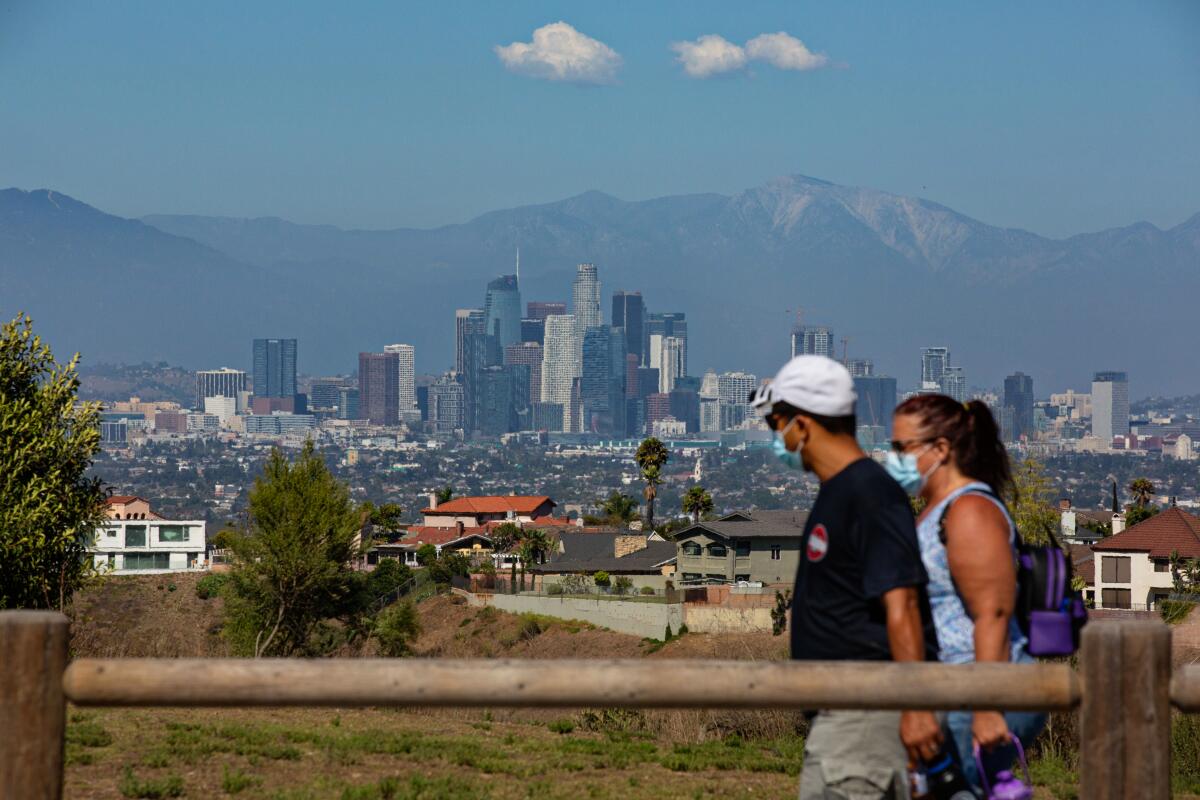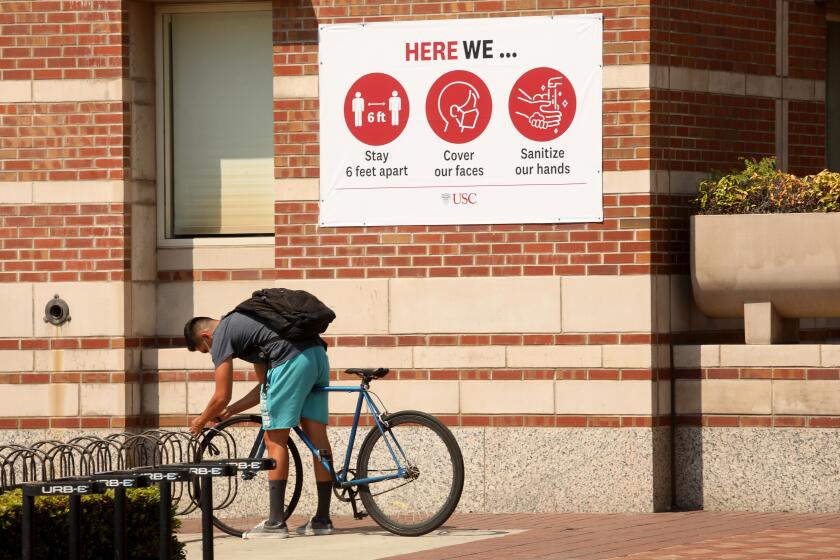Dangers of third coronavirus surge in California focus on young people, essential workers

- Share via
SAN FRANCISCO — Even as California finally begins to see declines in both COVID-19 deaths and hospitalizations, health officials and experts are preparing for a potential third surge of coronavirus cases fueled by two groups that already have been hit hard: low-wage essential workers and young people.
The summer spike in COVID-19 has started to ease, and governments soon will need to consider how they might begin to reopen the economy further. Gov. Gavin Newsom is expected to outline his plans Friday.
California’s first effort at reopening was disastrous, with the spring’s worst weekly death counts doubling to nearly 1,000 during the summer. Last week’s total fell to about 900.
There already are warning signs about what the fall may bring.
Even though most college campuses remain closed, there have been outbreaks recently, at USC and UC Berkeley for example, tied to fraternities. Large outbreaks persist at workplaces staffed by low-income employees, working in jobs like garment manufacturing and food processing that are largely staffed by Latinos.
Just a week into fall semester, USC reported that 43 students had tested positive for COVID-19 and more than100 placed in quarantine because of exposure.
A new surge in the pandemic is far from a certainty — but experts said it’s essential that California learn from the mistakes of the last reopening. Of the more than 12,600 California COVID-19 deaths so far, more than 8,800 have been reported since Memorial Day, around the time the economy began to reopen and some people got back to old routines.
“Where I’m worried that we’re going to see a ton of transmission is in middle schools, high schools and colleges,” said Dr. George Rutherford, UC San Francisco epidemiologist and infectious diseases expert. “We all saw the disastrous openings at the University of North Carolina, Notre Dame, Michigan State ... and a couple weeks earlier in high schools in Georgia and other places. I think that’s really where a lot of the action is going to go on.”
Rutherford and others also have concerns about Latino workers and their families, who account for a disproportionate share of COVID-19 cases and deaths in California and will be placed at even greater risk when the economy reopens further. Businesses that employ low-income essential workers have come under scrutiny for their health and safety practices.
Robust coronavirus testing that yields results much faster must be at the centerpiece of a broad reopening of society, experts say. Physicians cheered Newsom’s announcement Wednesday of a $1.4-billion contract with an East Coast medical diagnostics company to more than double the number of tests that can be processed in the state.
The goal is to get test results back within 24 hours, a time frame that will be far more useful to controlling the pandemic than currently, where the average turnaround time can take up to seven days, Newsom said.
“The entire way we control this pandemic — after we do masks and distancing — is for people to be able to test, get results quickly, and then make decisions based on those results,” said Dr. Kirsten Bibbins-Domingo, chair of UC San Francisco’s Department of Epidemiology and Biostatistics.
Test results that come back a week later are essentially worthless in helping to slow the spread of disease, because those infected will already have been past the point at which they were transmitting the most amount of virus, Bibbins-Domingo said.
Quick results also are profoundly important to making contact tracing — where county officials reach out to the close contacts of newly diagnosed people to ask them to get tested and quarantine themselves — a valuable tool to slow the pandemic. A seven-day turnaround time for test results “makes not only testing worthless, but the contact tracing activities that follow worthless,” Bibbins-Domingo said.
Colleges, where students live in close quarters in dorms and like to party, will be especially tricky to reopen. It’s hard to imagine how colleges can more fully reopen without large-scale testing, Bibbins-Domingo said.
The data offer clues into how a new surge of disease could hit.
Adults ages 18 to 49 now make up 60% of coronavirus cases, despite being just 44% of California’s population. They also currently account for 31% of all COVID-19 hospitalizations in Los Angeles County, up from 23% in mid-March.
Among racial and ethnic groups, 60% of California’s cases are being diagnosed among Latinos, who comprise 39% of the population.
The state’s economic reopening should happen at a slower, more methodical pace, said Dr. Robert Kim-Farley, medical epidemiologist and infectious disease expert with the UCLA Fielding School of Public Health.
While California’s COVID-19 hospitalizations and deaths have fallen, they’re still way above the springtime plateau.
“I don’t think that we should open up again until we are below that first plateau … and then I think what we need to do is a more phased approach in that reopening,” Kim-Farley said. For instance, officials should wait two to three weeks between each phase of its reopening process before moving on to a broader reopening, to see if the previous action worsened disease transmission.
Los Angeles County health officials also have urged caution. The effective transmission rate in L.A. County is 0.92, meaning every person infected on average is infecting another 0.92 people. While such a rate indicates cases will continue to decline, there are reasons to be worried.
The disease transmission rate “is still very, very close to 1, which means that any relaxation of the precautions that people take could result in the numbers climbing back up,” said Dr. Christina Ghaly, director of health services for L.A. County. “It’s up to each and every one of us to continue the practices that will allow that progress to be maintained until we have a virus vaccine.”
In both L.A. County and Orange County, health officials have suggested slower approaches to a new round of reopening.
“We all have learned that the earlier reopening ... brought about transmission,” said Dr. Clayton Chau, director of the Orange County Health Care Agency. “So I think we have learned from that lesson, and my recommendation would be, we will reopen in phases.”
He added: “There will be outbreaks. And that’s the thing that keeps me up at night.”
“It would not be a good idea to move with haste on reopening plans, until we can make sure that we get through Labor Day, with people acting appropriately and us taking all of the precautions,” said Barbara Ferrer, the L.A. County public health director.
It’ll also be important to get the flu shot, as hospitals can ill afford to withstand a “twindemic” of hospitalized flu patients at the same time as COVID-19 patients. Flu shots have already started to become available.
Some business closures ordered by the governor may have to stay in place for the foreseeable future.
Dr. Anthony Fauci, the U.S. government’s top infectious diseases expert, recently told actor Matthew McConaughey in a 40-minute interview on Instagram how much he loved to go to a bar after work with his wife to have a beer and a hamburger. But now is not the time for barhopping.
“Give it up for now. Bars are the hotspots. No hanging out in bars,” Fauci said. “Because we know when the bars get closed, the infection goes down. When people just let it rip and go to bars, it goes up.”
Lin reported from San Francisco, Lee from Los Angeles. Times staff writers Colleen Shalby and Phil Willon contributed to this report.
More to Read
Sign up for Essential California
The most important California stories and recommendations in your inbox every morning.
You may occasionally receive promotional content from the Los Angeles Times.













